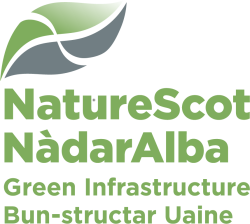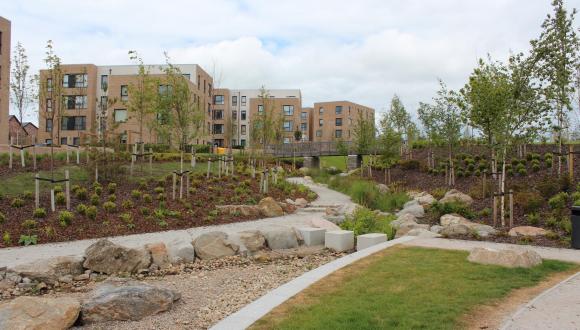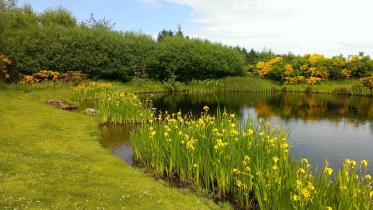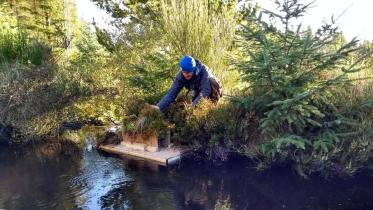Green Infrastructure - Communications Toolkit
Green Infrastructure Fund - Guidance for Applicants
Disclaimer
Applicants should be aware that as the Green Infrastructure Fund is a new programme, the guidance will be reviewed as the programme evolves and therefore may be subject to change. The European Union and Scottish Ministers reserve the right to amend the National Rules and NatureScot reserves the right to amend the published guidance during the period of the programme. Decisions to fund Projects will be based on the availability of funding, how well the project matches the Green Infrastructure Fund priorities and its contribution to outcomes as part of the whole Strategic Intervention. These priorities may change during the course of the Strategic Intervention to take into account gaps in meeting priorities in previously funded Projects and not to fund at all. The Scottish Government reserves the right not to award any support at all under this programme.
|
21/12/15 |
V1 |
Draft |
David Roger |
ZK |
|---|---|---|---|---|
|
15/1/16 |
V1 |
Final |
MF |
ZK |
|
17/10/16 |
V2 |
Final |
MF |
DP |
|
21/9/18 |
V3 |
Final |
MF |
FS |
|
12/10/20 |
V4 |
Draft |
MF |
FS |
Purpose
This Communications Toolkit aims to help applicants inform and engage with stakeholders about the Green Infrastructure Fund and individual projects.
Whoever you’re talking to, the guidance within the Toolkit will keep your communications about Green Infrastructure Fund relevant, clear and consistent.
You’ll find a short project summary and key messages about the Green Infrastructure Fund for stakeholder audiences and the tools you need to plan and deliver communications effectively. This includes guidance on applying the Green Infrastructure Strategic Intervention brand to external communications materials, a communications plan template, and a media protocol.
We are keen to hear your feedback on this Toolkit and welcome any suggestions to improve it. Please email any feedback to the Green Infrastructure Team – [email protected].
Project Summary and Key Messages
Introduction
This section of the Toolkit provides a short project summary and a set of key messages about the Green Infrastructure Strategic Intervention and Green Infrastructure Fund, which can be incorporated in applicants’ communications.
The project summary and key messages should be used in conjunction with the following sections:
- Brand Guidelines
- Communications Planning
- Working with the Media
Project Summary
The Green Infrastructure Strategic Intervention is a major new programme of projects, partfunded through the European Regional Development Fund (ERDF), which will make our larger towns and cities more attractive, equal and environmentally sustainable places to live, work and invest in.
The Green Infrastructure Strategic Intervention is targeted at urban areas in Scotland that have a shortage of good quality greenspace, and suffer from multiple deprivation and a surplus of vacant and derelict land. Investing in good quality green infrastructure in these urban areas makes sound economic sense and will deliver a wide range of social and environmental benefits. The Green Infrastructure Strategic Intervention will help improve people’s health and well-being and reduce inequalities, provide better opportunities for local communities to experience and value nature, and contribute to economic regeneration and growth by creating better places and enhance the quality of life of urban dwellers in our larger towns and cities.
NatureScot has been confirmed as the Lead Partner for the Green Infrastructure Strategic Intervention for the period to 2023. NatureScot will deliver the Green Infrastructure Strategic Intervention through an open and competitive Challenge Funds, the Green Infrastructure Fund, which will select projects with substantial and transformative impact for deprived urban communities. This will be an open and competitive selection process to select the very best Projects to deliver the Green Infrastructure outcomes. NatureScot will report to The Scottish Government, as the Managing Authority, on overall progress.
The total investment through the Green Infrastructure Fund will be over £40m by 2023.
The Green Infrastructure Fund will provide a contribution of up to 40% of eligible costs. The ERDF contribution is valued at £15m to 2023.
Key Messages
This set of standard messages describes the Green Infrastructure Strategic Intervention and the Green Infrastructure Fund, and the benefits that green infrastructure projects will bring to local communities in urban areas across Scotland. These messages can be tailored for use with the local stakeholder audiences for individual projects:
- The Green Infrastructure Strategic Intervention is a major new Scottish programme of investment, led by NatureScot which will green our larger towns and cities;
- (Name of Grantee) is working together with NatureScot and other partner organisations to deliver green infrastructure projects that will deliver many benefits for local communities, helping to unlock economic potential and creating better places to live and work in;
- These green infrastructure projects are part-funded through the European Regional Development Fund (ERDF);
- Green infrastructure projects work with nature to enhance the natural resources – clean water, clean air, healthy soils and vegetation – that our lives depend on;
- Good quality green infrastructure in our towns and cities will improve people’s health, provide recreational spaces, save energy and create economic opportunities and jobs;
- Having good quality green infrastructure near where we live and work will improve our physical and mental health and well-being;
- Green infrastructure projects will make an important contribution to a future low carbon economy for Scotland;
- There are lots of opportunities close to home for people to enjoy and help look after their local greenspace and nature;
- Get active in your local greenspace and feel the benefits;
- Environmental volunteering and community action can develop your confidence and skills, improving your employability.
Brand Guidelines
Introduction
The Green Infrastructure Fund has a distinct brand for use on all external communications materials.
This section of the Toolkit provides guidance for applicants as to how the Green Infrastructure Fund brand should be applied on all external communications materials relating to the Green Infrastructure Fund and individual projects. This will ensure consistent messaging reaches all stakeholder audiences, helping to build recognition of Green Infrastructure Fund and increasing the efficiency and effectiveness of communications efforts.
Branding Requirements
The Green Infrastructure Fund brand should be applied consistently to all external communications materials produced by Grantees. This will be a condition of your contract with us should your application to the Green Infrastructure Fund be successful.
The Green Infrastructure Fund brand should always be used alongside The Scottish Government’s European Regional Development Fund (ERDF) logo. It is a condition of grant that any assistance received by a project from the European Union through Scotland’s European Structural Fund (ESIF) Programme is clearly and appropriately acknowledged in all publicity material (including plaques and signage), publications, promotional merchandise, websites, information events, and technical/public procurement documents.
Please read The Scottish Government’s publicity requirements in conjunction with the Green Infrastructure Fund Brand Guidelines.
The Green Infrastructure brand is a subsidiary of the NatureScot brand. Using the main NatureScot brand on Green Infrastructure Fund supported projects is not required.
Further information
If you require a copy of the Green Infrastructure Fund logo, or if you have a question about Green Infrastructure Fund branding, please contact the Green Infrastructure Team – [email protected].
The Brand
The Green Infrastructure Fund brand consists of a unique logo and set of colours.
The Scottish ERDF programme is the only one in the UK with a green infrastructure element.
The logo
The downloadable logo comprises three elements:
- a flag;
- a title ‘NatureScot’;
- a strapline ’Green Infrastructure’.

- Green Infrastructure logo master RGB PNG
- Green Infrastructure logo master RGB JPG
- Green Infrastructure logo colour CMYK JPG
- Green Infrastructure logo colour CMYK PDF
- Green Infrastructure logo white PNG
- Green Infrastrucutre logo white PDF
The Green Infrastructure Fund logo is available in JPEG and PNG file formats and can be downloaded directly from the links above. The logo should not be altered, re-coloured, manipulated or distorted in any way.
The full colour version of the Green Infrastructure Fund logo should be used wherever possible.
The colours
The colours are unique to the Green Infrastructure Fund logo.
Logo size
You can download the ERDF logo.
The Scottish Government’s publicity requirements states that the ERDF logo must be displayed at a minimum width of 45mm and that other logos used must be of a similar size. There is no maximum size restriction. The guidelines for the size of the Green Infrastructure Fund logo are set within this context and shown in the grid below. Logos must always be legible and retain quality of definition when enlarged or reduced.
|
Minimum size |
69mm |
45mm |
|---|---|---|
|
A4 |
69mm |
45mm |
|
A3 |
100mm |
65mm |
|
A2 |
107mm |
70mm |
|
A1 |
123mm |
80mm |
Logo position
To maintain the legibility of the Green Infrastructure Fund logo it should be placed on a neutral background, preferably white, and should not be obscured or infringed by other text or graphics. The Scottish Government’s publicity requirements has detailed guidelines for the position of the ERDF logo within external communications materials. The use of the Green Infrastructure Fund logo follows this guidance.
Billboards and plaques
On billboards and plaques that are different sizes to those specified in the grid above, the ERDF logo is to take up 25% of the total available area. The Green Infrastructure Fund logo should take up 15% of the total available area and be placed on the same level as and to the left of the ERDF logo.
Sample of plaque
Fernbrae Meadows - A community park offering a nature-rich and quality greenspace for local residents. Part-funded by the European Regional Development fund.
NatureScot and South Lanarkshire council on the left. ERDF/Scottish Government logo on the right.
Posters
Where a billboard or plaque is not required, posters should be a minimum A3 size. The ERDF logo should be placed to the top right or bottom right corner and be a minimum 65mm in size. The Green Infrastructure Fund logo should be in the opposite corner to the ERDF logo and the size should be in accordance with the guidelines.
Documentation and promotional merchandise
The ERDF logo should be placed in the top right-hand corner and the Green Infrastructure Fund logo should be placed on the same level in the top left-hand corner. The logo size should be in accordance with the guidelines.
All documentation relating to the promotion and publicity of ESIF operations must be retained for audit purposes. This includes documents relating to recruitment adverts, attendance sheets, certificates and publicity merchandise (stationery, banners, and visual presentations). If an operation cannot provide documentary evidence it will be assumed they have not fulfilled the publicity requirements and may result in them having to repay ESIF funding awarded. The retention dates for any documentation or promotional materials can be found in the ESIF document retention guidance under Document Retention Periods.
Care should be taken in storing copies of press mentions and articles relating to projects. All mentions should be recorded, but only hard (physical) clippings of newspaper mentions and articles can be retained – you cannot retain digital copies of press mentions or articles due to copyright legalisation. Where a mention or article only appears as part of an online presence the URL should be stored for later reference.
With regard to recruitment campaigns it is essential that all those taking part in an operation are aware that it is part funded through the European Structural Funds. This includes both Lead Partners and the staff of the Delivery Agent recruited to develop and deliver the operation. Therefore any recruitment adverts and participant or business support records must clearly state that the operation is part funded by the European Structural Funds and must display the appropriate logo.
Social Media
Projects must consult the European Structural and Investment Funds (ESIF) programmes documentation to ensure that they meet ESIF Publicity Requirements. Example social media hashtags include #ESIF #ESF #ERDF and #europeanstructuralfunds
Websites
The Green Infrastructure Fund and ERDF logos should be clearly displayed on the appropriate webpage(s) to acknowledge the funding support. The ERDF logo should be at least 146 pixels by 109 pixels in size and be placed in the top right-hand corner, or as close as possible, of the webpage and link to the European Structural Funds website. The Green Infrastructure Fund logo should be placed at the same level as the ERDF logo on the opposite left-hand corner, or as close as possible, and be of equivalent size.
As a guide, NatureScot’s Green Infrastructure Fund website uses the logo as follows:

Green Infrastructure Strategic Intervention logo placed on the left-hand side, opposite the ERDF logo. ERDF logo is required to be placed on the right-hand side.
Communications Planning
Introduction
Communications planning is a straightforward, step-by-step process that will help applicants clearly summarise what they want to say to their audience about the Green Infrastructure Fund and individual projects and map out how to deliver these messages.
Communications planning is also an ongoing activity. The purpose, audience, messages, and channels may change, but the need to maintain relationships with the media and with key people in the local community remain. So it is important to continue to use and revise the communications plan, based on your experience, throughout the existence of the project.
One way to look at planning for communication is as an eight-step process. The steps are:
- Identify the purpose of your communications;
- Identify your audience(s);
- Plan and design your key message(s);
- Consider your resources;
- Plan contingencies to deal with problems;
- Plan how you’ll connect with the media and other influencers who can help you spread your message(s);
- Create an action plan (tactics);
- Decide how you’ll evaluate your plan and adjust it based on the evaluation results.
The following communications plan template will help you work through and pull these elements together into a ‘living’ document ready for implementation and monitoring of activities.
Communications Plan Template
|
Project Name |
|
|
Project Outcome(s) |
|
|
Communications Contact |
|
|
Period of the Communications Plan |
|
|
Overview of Communications Opportunities and Challenges |
|
|
Purpose of Communications What are the specific outcomes required for the project? Ensure each outcome is stated clearly, detailing what it is that we wish to achieve with this project – what will be different as a result of this work? Please number the outcomes and refer to the number when detailing the target audience and key messages if appropriate. |
|
|
Audience(s) Who are the target audience(s) for the communications activity? Please describe the audiences as specifically as possible. If there are several outcomes listed for the project, ensure that the target audience is detailed for each one. Please give each audience a number, corresponding to the outcome to which it relates. |
|
|
Key Messages What messages are we trying to communicate? Please give each message a number, corresponding to the outcome to which it relates. |
|
|
Resources What financial and human resources can you commit to communications? Include details of budget, people, staff time. Include other resources such as information, public support, etc. |
|
|
Contingency Planning Crisis planning should be part of any communications plan in order to anticipate problems and deal with them effectively. Cover as many situations as possible and include details of who takes responsibility for what – dealing with the media, correcting errors, etc. |
|
|
Connecting with the media and other influencers Establishing and sustaining good and open relationships with individual media contacts, and with influential individuals and institutions in the community you are trying to reach, is a vital part of the communications plan. |
|
|
Action Plan (Tactics) This should bring all the above elements together into a plan you can act on. Include details of outcomes sought, target audiences, what your key messages should contain and look like, what channels to use to reach audiences, what problems you might face, budget, timing, staff responsibilities. |
|
|
Evaluation By evaluating your communications plan, you’ll learn which activities had the most impact, and which parts of the plan didn’t work, allowing you to make changes to improve communications. Consider formal measurement techniques for measuring results against outcomes – e.g. focus group sessions – or less formal evaluation methods such as assessing media coverage. |
|
Working with the Media
Introduction
The media have a very important role in communicating information about the Green
Infrastructure Strategic Intervention to all stakeholder audiences. The Green Infrastructure Fund Team values the media as one of its key partners in communication and we will forge strong professional links with local, regional and national media. Every media enquiry must be used as a positive opportunity to get key messages about the Green Infrastructure Strategic Intervention across to our audiences.
To ensure we work with the media in a careful and coordinated way, the following is a protocol that will be agreed between the Lead Partner - NatureScot - and applicants. It covers:
- media relations;
- the writing and issuing of press releases;
- procedures for releasing information to the media.
Please note that the primary NatureScot contact for all media relations for Green Infrastructure Strategic Intervention is:
Catriona Webster Tel: 0131 316 2638
Communications Officer, E-mail: [email protected]
NatureScot
Silvan House, 3rd Floor East
231 Corstorphine Road
Edinburgh
EH12 7AT
Media Protocol
Name of the project
The official name of the project is the Green Infrastructure Fund.
Tone
The tone of external communications will be positive, open, honest and factual, even if faced with criticism.
Key messages and sound bites
Applicants should use the following key messages as background for news releases and other publicity:
- Green infrastructure projects work with nature to enhance the natural resources – clean water, clean air, healthy soils and vegetation – that our lives depend on;
- Good quality green infrastructure in our towns and cities will improve human health, provide recreational spaces, save energy and create economic opportunities and jobs;
- Having good quality green infrastructure near where we live and work will improve our physical and mental health and well-being;
- Green infrastructure projects will make an important contribution to a future low carbon economy for Scotland;
- There are lots of opportunities close to home for people to enjoy and to help look after their local greenspace and nature;
- Environmental volunteering and community action can develop your confidence and skills, improving your employability.
Media queries/contacts
If Grantees receive media queries, they should inform NatureScot as soon as possible. When appropriate, broader Green Infrastructure Strategic Intervention queries should also be referred to as NatureScot. If time allows, send statements to NatureScot for review before sending them to the media. Contact Catriona Webster, Communications Officer (0131 316 2638 or [email protected])
News releases and publicity
As the Lead Partner, NatureScot should always be credited, if possible, in any news releases, articles and other publicity items.
All news releases must acknowledge the funding received from the European Regional Development Fund (ERDF) and include the full name of the fund and the amount of funding allocated to the project. Copies of news releases should be retained in project files for audit purposes.
In describing the project, the following paragraphs should be used:
- The <add name> project is part of a major new £37.5 million Scottish programme of projects to improve the urban environment of our larger towns and cities. The Green Infrastructure Strategic Intervention is led by NatureScot and is part-funded through the European Regional Development Fund (ERDF).
- With 81% of Scotland’s population living in urban areas, the Green Infrastructure Strategic Intervention will make our larger towns and cities more attractive, equal and environmentally sustainable places to live, work and invest in. It is a Scotland-wide initiative with many partners, including local authorities and housing associations.
News releases should be circulated to NatureScot for review and comment (and for a quote to be included when appropriate). When possible, please allow 72 hours for feedback. Please note that email news releases may be sent without logos as plain emails (without attachments) to prevent rejection by the recipient.
News releases: notes to editors section
In news releases, the following information must appear in the “Notes to Editors” section:
Green Infrastructure is planned greenspace and water that uses the natural environment to provide environmental and quality of life benefits.
The Green Infrastructure Strategic Intervention is funded through the European Regional Development Fund (ERDF) with a £15 million investment in urban Scotland. The Green Infrastructure Strategic Intervention is co-ordinated investment in green infrastructure, targeting those urban communities in Scotland that are most disadvantaged, which will help increase the accessibility, quantity and quality of greenspace, ensuring that people have access to good quality spaces for recreation and health. For more information about the Green Infrastructure Strategic Intervention and Green Infrastructure Fund, visit our webpages
The Scottish Government is the Managing Authority for the European Structural
Funds 2014-20 Programme. For further information, visit their website or follow @scotgovESIF.
NatureScot is the government's adviser on all aspects of nature and landscape across Scotland. For more information, visit our webpages and twitter
Broadcast interviews
Please inform Catriona Webster, NatureScot Communications Officer for any requests for radio or TV interviews.
Please consider, if appropriate, NatureScot staff as potential interviewees. Verbal communications (e.g. media interviews, public talks) must acknowledge ERDF funding support and give credit to NatureScot as the Lead Partner for Green Infrastructure Strategic Intervention as circumstances permit.
NatureScot’s Gaelic Officer is available to provide Gaelic media interviews. Such enquiries can be managed through Catriona Webster
Media relations contact details
Please provide contact details for staff who will handle media relations for your projects to Catriona Webster.
Pool video and images
Internal video/images captured during the lifetime of the project remain the copyright of the partner organisation. These should be made freely available to NatureScot on request. If NatureScot uses the material, we will credit the partner organisation.
Commissioned or in-house newsletter/magazine articles
Commissioned and website articles should acknowledge the project partners with the agreed information about the project and should refer interested parties to our webpages.
Applicants should seek to publicise the project in their internal communications – e.g. Intranet, in-house publications - whenever possible. Proofs should be sent to [email protected] for review before publication, where possible.
Published: 2020





